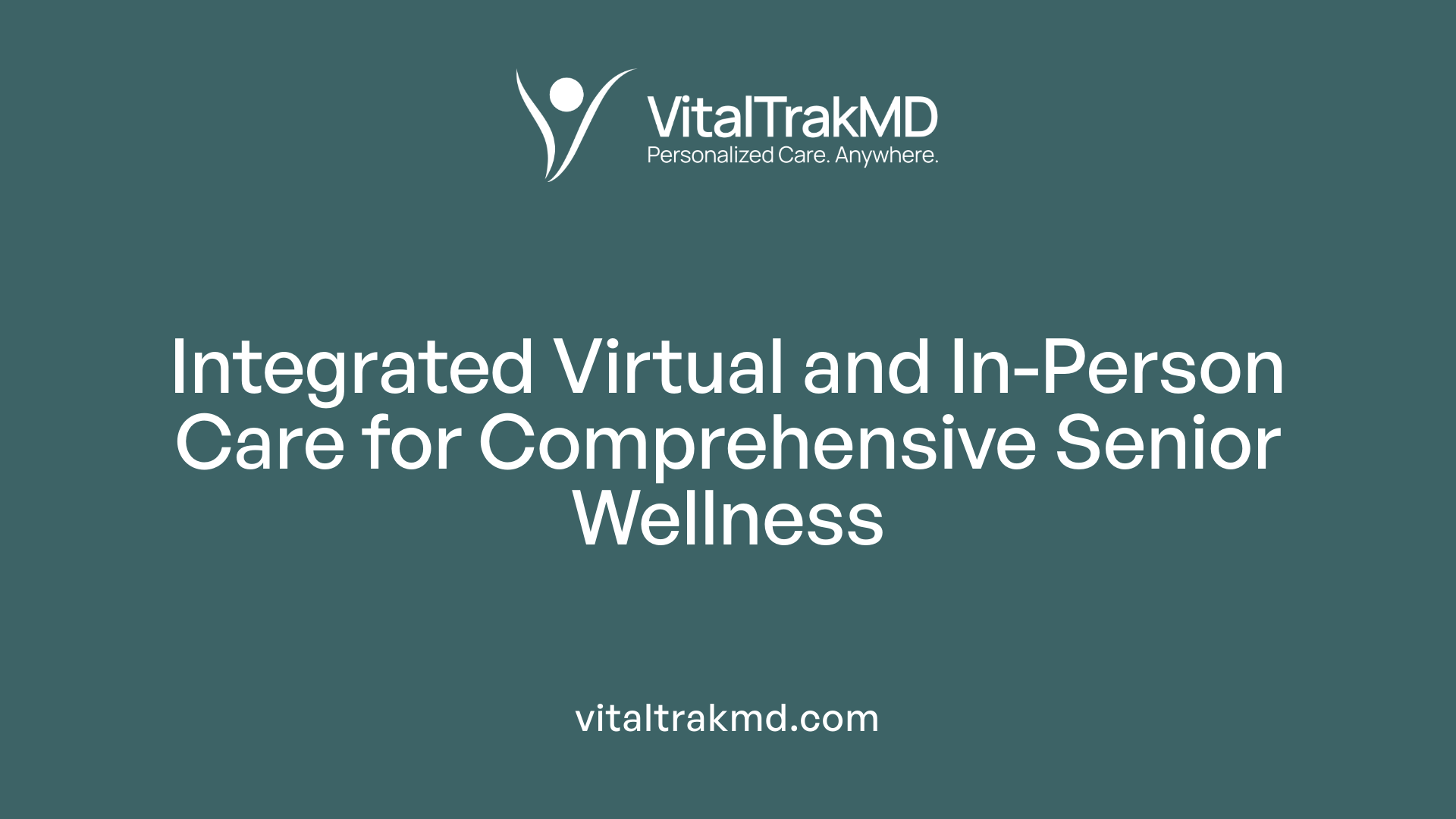Benefits of Dual Virtual and In-Person Visits for Senior Wellness

Combining Virtual and In-Person Healthcare for Optimal Senior Wellness
As the population ages, there is an increasing need for innovative healthcare models that support the unique needs of older adults. Integrating virtual (telemedicine) and in-person visits presents a promising approach, offering flexibility, improved access, and better health outcomes. This article explores the multifaceted benefits of dual care modalities, emphasizing how they bolster senior wellness, reduce disparities, and sustain aging in place.
The Advantages of Telehealth in Senior Care

What are the benefits of telehealth versus in-person visits for older adults?
Telehealth has emerged as a transformative approach in senior care, offering numerous advantages over traditional in-person visits. For older adults, especially those with mobility challenges, chronic health conditions, or residing in remote areas, telehealth provides an accessible, convenient way to connect with healthcare providers without the need for physical travel.
One of the most notable benefits is the convenience of accessing medical consultations from home. This flexibility helps older adults maintain independence, reduce effort, and avoid transportation issues that can be especially daunting during harsh weather or for those with limited mobility.
In addition, telehealth supports a broad spectrum of healthcare needs, including managing chronic diseases like diabetes, hypertension, and heart failure, as well as behavioral health services and preventive care. This continuous engagement helps in early detection of health issues and timely interventions, often leading to a decrease in hospitalizations and emergency visits.
Real-time symptom monitoring and remote patient management facilitate personalized treatment plans. For example, remote monitoring devices can track vital signs such as blood pressure or glucose levels, allowing healthcare providers to make immediate adjustments to medications or treatment strategies. This proactive approach promotes better health outcomes and enhances patient safety.
Many older adults report high satisfaction levels with telehealth, underscoring its effectiveness and acceptance. Virtual visits can be scheduled more flexibly, and patients appreciate the reduced wait times, easier appointment access, and the ability to include family members in consultations, even from afar.
While some technological challenges exist, such as unfamiliarity with devices or concerns over privacy, these can be addressed through caregiver support, user-friendly platforms, and proper training.
In summary, telehealth not only makes healthcare more accessible for seniors but also amplifies the quality of care by enabling continuous, personalized, and timely medical attention, thus supporting healthier aging and improved quality of life.
Addressing Challenges in Telehealth Adoption

What are the challenges faced by older adults in using telehealth?
Older adults encounter several obstacles when adopting telehealth services. One of the primary issues is technological literacy. While approximately 37% of adults aged 65 and above used telemedicine in 2021, many faced difficulties with setup, navigation, and understanding how to operate the platforms effectively. This difficulty often led to technical disruptions; in fact, about 27% of seniors who scheduled video visits had to switch to phone-only consultations due to technical problems.
These problems diminish the overall user experience and can discourage ongoing use of telehealth. Older adults also harbor privacy and security concerns. Uncertainty about data protection and fear of breaches can reduce their confidence in virtual care, especially if they are unfamiliar with digital security protocols.
Another significant barrier is the lack of reliable broadband or suitable devices. Not all seniors have access to high-speed internet or modern smartphones and tablets necessary for seamless video communication. Consequently, audio-only telehealth options have become crucial, allowing those without adequate technology to still access healthcare services without sacrificing continuity of care.
To mitigate these challenges, tailored solutions are vital. Healthcare providers and caregivers can support older adults through dedicated training sessions, simplified user interfaces, and ongoing technical assistance. Additionally, integrating telehealth platforms that require minimal technological expertise, and offering support via phone or local clinics, can improve accessibility.
Addressing these barriers is essential to maximize the benefits of telehealth for seniors, ensuring they can participate fully in virtual health management and avoid disparities caused by digital divides.
The Significance of Hybrid Healthcare Models

How do hybrid healthcare models improve access and outcomes for older adults?
Hybrid healthcare models, which integrate in-person visits with telemedicine and remote monitoring, are transforming the way care is delivered to older adults. These combined approaches significantly enhance access by reducing common barriers such as transportation difficulties, mobility limitations, and geographic isolation. For seniors living in rural areas or those with chronic conditions, hybrid models offer a flexible and consistent means of managing health.
By providing continuous, personalized care, hybrid systems support better management of chronic illnesses like diabetes, hypertension, and heart disease. For example, remote monitoring devices allow healthcare providers to track vital signs and health data in real time, enabling early intervention and timely adjustments to treatment plans. This proactive approach helps prevent complications and hospitalizations.
Moreover, hybrid models foster improved engagement and communication. Patients can participate in virtual follow-ups, mental health counseling, and preventive care sessions, often from the comfort of their homes. This convenience encourages adherence to care plans and regular check-ins.
Care coordination across multidisciplinary teams becomes more seamless with integrated digital platforms. Family members can also be involved in virtual appointments, especially beneficial when they live far away. This participation enhances understanding, compliance, and emotional support.
Health outcomes are further improved by reduced missed appointments, optimized resource utilization, and increased patient satisfaction. Many seniors appreciate the flexibility of combining virtual consultations with necessary in-person exams, which together support aging in place.
Hybrid healthcare models effectively bridge gaps in care for the most vulnerable populations, including underserved minority groups and those with lower socioeconomic status. They promote health equity by expanding the reach of healthcare services, ensuring that distance, transportation, or physical limitations no longer hinder access.
In summary, hybrid approaches empower older adults to stay healthier, more independent, and better connected to their healthcare providers. They enhance overall health outcomes while respecting patient preferences and promoting affordability.
| Benefits | Description | Impact |
|---|---|---|
| Increased Access | Reduces transportation and mobility barriers | Facilitates care for rural, disabled, and socially isolated seniors |
| Personalized Care | Continuous monitoring and tailored interventions | Improves management of chronic diseases and mental health |
| Flexibility in Scheduling | Combines in-person and virtual visits based on need | Optimizes appointment timing and reduces missed visits |
| Care Coordination | Integration of multidisciplinary teams via digital platforms | Ensures comprehensive, cohesive care delivery |
| Supports Aging in Place | Enables seniors to remain in their homes longer | Promotes independence, improves quality of life |
More about hybrid healthcare models for seniors
Research and practical implementations reveal that combined care approaches lead to better health outcomes, higher patient satisfaction, and reduced healthcare costs. Policies from authorities like the AMA support expanding these models by removing restrictions on telehealth services, integrating remote monitoring into standard care, and facilitating cross-sector collaboration.
Overall, the hybrid healthcare approach stands out as a robust, adaptable, and patient-centered way to meet the complex needs of aging populations, ensuring they receive the right care at the right time—delivered in the most appropriate setting.
Supporting Aging in Place with Technology

What role does telehealth play in supporting aging in place and comprehensive senior care?
Telehealth serves as a vital tool for enabling older adults to age comfortably within their own homes. It provides accessible, coordinated healthcare services that reduce the need for physical travel and in-person visits.
One of the pivotal features of telehealth is remote monitoring. Devices such as blood pressure cuffs, glucose monitors, and wearable health trackers allow continuous data collection. Healthcare providers can oversee vital signs in real-time, enabling early detection of health issues like hypertension or diabetes complications. This proactive approach not only minimizes emergency hospital visits but also supports personalized care plans tailored to individual needs.
Virtual consultations support effective management of chronic conditions, medication schedules, and preventive health services. Patients can connect with primary care physicians, specialists, and mental health professionals from the comfort of their homes. This flexibility helps older adults maintain independence, especially those facing mobility challenges.
Mental health support is another important aspect. Through telepsychiatry and remote therapy sessions, seniors can access behavioral health services that address feelings of loneliness, depression, and anxiety. Such access to mental health care is crucial for holistic senior well-being.
Family participation in care is facilitated via virtual visits. Caregivers and loved ones can join appointments, discuss care strategies, and support decision-making, fostering a collaborative environment that enhances care continuity.
Moreover, telehealth solutions help alleviate caregiver strain by providing easier access to medical advice, follow-ups, and social services, reducing the physical and emotional burden of caregiving.
In totality, telehealth creates a comprehensive framework supporting aging in place by integrating medical, mental, and social care components. It promotes independence, improves health outcomes, and ensures that seniors can live safely and comfortably within their communities.
How do remote monitoring, case management, medication adherence, mental health support, and family involvement coalesce to improve senior care?
| Aspect | Description | Impact |
|---|---|---|
| Remote Monitoring | Devices track vital signs and health metrics continuously | Early detection of health issues, reduces hospitalizations |
| Case Management | Coordinated care plans by multidisciplinary teams | Personalizes care, tracks progress, adjusts treatments |
| Medication Adherence | Digital reminders and virtual check-ins | Prevents adverse events, ensures correct medication use |
| Mental Health Support | Teletherapy and virtual social groups | Reduces depression, enhances emotional well-being |
| Family Participation | Virtual visits with loved ones included | Strengthens support network, improves care cooperation |
This integrated approach fosters a proactive, connected, and patient-centered model of senior care that enhances quality of life and health outcomes.
Enhancing Care Quality and Coordination

What are the benefits of combining virtual (telemedicine) and in-person visits for senior wellness?
Integrating telemedicine with traditional in-person care creates a hybrid model that significantly benefits older adults. This approach enhances access to healthcare services, especially for those with mobility issues, chronic illnesses, or living in remote areas. By combining virtual consultations with periodic face-to-face visits, healthcare providers can ensure continuous, timely care that adapts to the patient’s evolving needs.
This method helps bridge disparities in healthcare access that can be influenced by race, ethnicity, income, and geography. For example, rural seniors benefiting from telehealth can receive specialist input without long-distance travel, while urban older adults might enjoy the convenience of virtual follow-ups for routine issues.
Hybrid models support early detection and ongoing management of chronic conditions such as diabetes, hypertension, and heart disease, by allowing frequent remote monitoring combined with in-person examinations when necessary. This reduces hospital admissions and emergency visits, fostering better overall health outcomes.
Further, combining virtual and in-person visits offers opportunities for proactive screening of social determinants of health, including housing, nutrition, and social support, which are vital components of comprehensive senior care.
Care plans become more personalized as digital platforms enable access to real-time health data, lab results, and medication adherence tracking. This facilitates timely interventions and tailored treatment adjustments, thereby improving the quality of care.
Seamless care coordination among multidisciplinary teams—such as primary care physicians, specialists, social workers, and caregivers—is made possible through integrated digital platforms. These platforms consolidate medical records, appointment schedules, and communication channels, ensuring everyone involved in the senior’s care stays informed and aligned.
Ultimately, this combined approach fosters a more inclusive, adaptable, and efficient healthcare delivery system. It supports aging in place preferences, maintains independence, and enhances overall satisfaction with healthcare services among older adults.
Legal and Policy Considerations in Telehealth Expansion

Can annual wellness visits be conducted through telehealth?
Yes, annual wellness visits (AWVs) can be performed via telehealth, including services delivered directly to the patient’s home. Under Medicare, providers are allowed to bill for AWVs using specific HCPCS codes G0438 (initial AWV) and G0439 (subsequent AWV). These services encompass comprehensive health risk assessments, cognitive screenings, prevention planning, and social health evaluations, all of which can be effectively delivered through virtual means.
Billing for these services is permissible at approved originating sites, which now include the patient’s home, hospitals, and clinics. This means that seniors can get preventive care without visiting a healthcare facility physically. Healthcare providers such as physicians, nurse practitioners, and physician assistants can perform and bill for AWVs when they ensure proper documentation and obtain virtual consent from the patient.
The ability to conduct AWVs via telehealth expands opportunities for preventive care, encouraging more seniors to participate in health assessments regularly. It promotes early detection of issues, ongoing health management, and healthier aging in place by making these critical services accessible remotely.
Reimbursement and billing policies
Reimbursement policies for telehealth data are evolving quickly. During the COVID-19 pandemic, federal and state governments relaxed many regulations, allowing higher billing flexibility. Medicare now reimburses many virtual services, including mental health counseling, chronic disease management, and preventive visits like AWVs.
Billing is generally done using standard procedure codes, but coverage specifics depend on the service delivered, the provider’s location, and the patient’s insurance plan. For example, Medicaid coverage for telehealth varies by state, with many states expanding coverage and reimbursement for phone and video visits.
Provider licensing and cross-state practice
A major challenge in telehealth expansion is ensuring providers are licensed in the patient’s state. Regulations require providers to hold a valid license to deliver care legally within each state. During the pandemic, some states temporarily eased licensing restrictions, allowing cross-state practice to enhance access.
Efforts are ongoing to establish interstate licensing compacts, enabling providers licensed in one state to practice in others more easily. The Federation of State Medical Boards has promoted initiatives to streamline licensing processes and facilitate more widespread telehealth services across state boundaries.
Medicare and Medicaid coverage for virtual services
Medicare has significantly expanded virtual care coverage, especially during the pandemic. It now covers a variety of telehealth services, including behavioral health, preventive screenings, and chronic care management, with particular allowances for older adults.
Medicaid programs vary widely by state, but many now offer comprehensive telehealth coverage, including audio-only services for seniors who lack access to video. This has been instrumental in reaching vulnerable populations and underserved rural areas.
Future policy developments and innovations
Looking ahead, policy discussions focus on permanent legislative measures to sustain and expand telehealth. The American Medical Association (AMA) advocates for lifting geographic and originating site restrictions permanently and broadening access to controlled substances via telehealth.
Innovations such as AI-driven diagnostics, wearable health technology, and integrated electronic health records will likely shape future policies. Policymakers are considering how to establish sustainable reimbursement models, ensure data security, and promote equity in access, especially for underserved communities.
In conclusion, legal and policy frameworks are evolving to support the continued growth of telehealth, aiming to improve healthcare accessibility, affordability, and quality for older adults and the broader population.
| Policy Aspect | Current Status | Future Directions | Notable Challenges |
|---|---|---|---|
| Reimbursement & Billing | Medicare covers many telehealth services, evolving post-pandemic | Permanent expansion of covered services, wider payer inclusion | Ensuring equitable reimbursement levels and managing fraud risk |
| Licensing & Practice Laws | Variability across states, temporary relaxations during COVID-19 | Interstate compacts, streamlined licensing | State-level regulation complexity, maintaining quality standards |
| Medicaid Coverage | Varies by state, many expanded to include audio-only services | Standardization and broadening of coverage | Funding constraints, disparities in access |
| Policy Innovations | Under active review, including AI & wearable tech integration | Legislation to support new technologies, enhanced security | Data privacy, technology disparities |
By addressing these policy areas proactively, authorities can build a more inclusive, efficient telehealth system that meets the needs of older adults and the healthcare industry as a whole.
Future Directions and Technological Innovations

What are the future prospects of telehealth in senior care?
The future of telehealth in aging populations is promising, with several technological advancements on the horizon that aim to improve care quality and accessibility for older adults. One major development is the integration of wearable health devices. These gadgets can continuously monitor vital signs such as blood pressure, glucose levels, and heart rate in real time, providing healthcare providers with valuable biometric data for proactive management.
In addition to wearables, artificial intelligence (AI) is increasingly being used for diagnostics and health assessments. AI-driven tools can analyze patterns from health data, enabling early detection of diseases such as cardiovascular issues, diabetes, or cognitive decline. This early warning system allows for timely interventions, potentially reducing hospitalizations and improving outcomes.
Enhanced internet infrastructure, especially broadband access, is crucial for bridging digital gaps. Upgrading connectivity in rural and underserved areas will facilitate smoother, faster, and more reliable virtual consultations, ensuring equitable access to care.
Creating user-friendly platforms tailored for older adults is another focus area. These platforms are designed with simplified interfaces, larger fonts, voice commands, and easy navigation to reduce technological barriers. This approach helps older users feel more confident and comfortable using telehealth services.
Moreover, the integration of virtual care with AI and data analytics is anticipated to support personalized healthcare. Smart virtual assistants can guide users through health management routines, remind them about medication schedules, and answer health-related questions, fostering greater independence.
Combining remote monitoring devices with these intelligent systems allows for continuous, personalized health interventions. Such proactive management supports aging in place, enabling seniors to maintain their independence while receiving high-quality medical support.
These innovations are expected to significantly reduce healthcare costs by decreasing emergency room visits, hospital stays, and unnecessary in-person appointments. Overall, the evolution of telehealth technologies promises a more connected, efficient, and personalized healthcare experience for older adults, enhancing their safety, well-being, and quality of life across various settings.
A Future of Inclusive, Flexible, and Accessible Elder Care
The integration of virtual and in-person healthcare visits is transforming senior wellness by fostering more accessible, personalized, and proactive care. Hybrid models bridge the gaps created by geographical, mobility, and socioeconomic barriers, ensuring that all seniors receive equitable, high-quality health services. As technology advances and policy frameworks evolve, these dual care approaches will become more seamless, leveraging innovations like remote monitoring, AI diagnostics, and user-centric platforms. Ultimately, embracing a combined care model supports aging in place, enhances quality of life, reduces disparities, and optimizes healthcare systems to meet the dynamic needs of our aging population. By prioritizing flexibility, safety, and inclusivity, healthcare providers and policymakers can shape a future where senior wellness is achieved through accessible and compassionate care.
References
- The Benefits of Telemedicine for Older Adults - Trualta
- Comparing In-Person Only, Telemedicine Only, and Hybrid Health ...
- Senior patients happy with telehealth and want it as care option
- [PDF] Older Adults' Experience With Virtual Care Two Years Into The ...
- Top 10 Reasons Why Telehealth Appointments Can be Beneficial
- 5 Benefits of Telehealth for Seniors | One Medical
- Older adults' perspectives on primary care telemedicine during the ...
- Why Telehealth is Important for Seniors | SelectQuote
Recent articles
Want to Feel Better and Live Healthier?
Join hundreds of patients taking control of their health with personalized care that fits their life – not the other way around.
Rated 4.8/5 by 32+ customers







